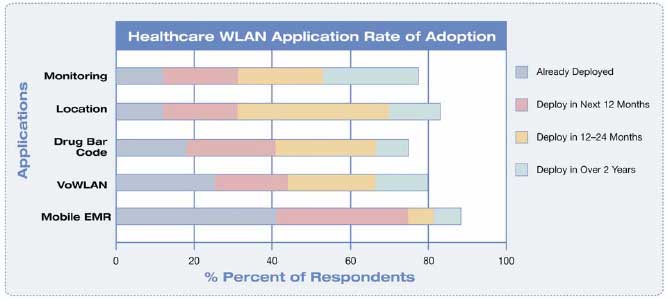
Things are changing in the WiFi market. At HIMSS 2007 I noted the booth traffic Aruba Networks and Meru garnered. There was also new comer Extricom who showed a wireless LAN that has a "one-channel" deployment, like Meru.
Since the show, I've heard rumblings of vendor trials at hospitals where the sales eventually went to someone other than Cisco. Until recently, Cisco was the undisputed IBM of networking, including wireless. You know, "no one ever lost their job buying Cisco." Well, it seems that those days may be over - at least for now.
Wireless networking vendor Aruba Networks has been gaining increasing momentum in health care lately. Aruba was selected by Welch Allyn as the preferred infrastructure for their new 802.11a/b/g radio embedded in their patient monitors, and for their nurse-carried alarm notification system (more here). Aruba's latest marketing vehicle is a market report titled: Healthcare WLAN Appliations: North American Hospital Survey Results. The report identifies the top five wireless LAN applications in hospitals - mobile EMR, VoWLAN, automated meds administration, WiFi-based indoor positioning systems, and wireless patient monitoring. At the right you can see that mobile support for EMR adoption leads the
application pack, and wireless VoIP runs a close second. Surprisingly,
automated meds administration is third, followed by indoor positioning
and monitoring. Note that most hospitals expect to deploy all 5
applications. (You can download your own copy of the paper here.)
The adoption of these 5 applications is roiling the wireless LAN market in health care; the reasons are bandwidth and mobility. While much is made about wireless LAN coverage, the challenges facing vendors are accommodating the bandwidth required by these apps, and providing the active management to ensure that the data streams for each of these apps meet the different requirements of each application. Implied in "active management" is the ability to also monitor each application's performance on the network. Word to the wise: the ability of current vendors to meet these requirements is highly variable. Make assumptions about what might be a "safe choice" (or take vendor statements at face value) at your own risk.
At HIMSS 2007 I spoke with Peter Mongroo of Aruba, who is their man responsible for the health care vertical. I was impressed with his (and Aruba's) understanding of the market, and especially what it means to put life critical data on the enterprise wireless LAN. Applications that demand true mobility and can come with heavy bandwidth loads can challenge wireless LANs. There are many highly technical issues, so techie that even my eyes started to roll up into my head. Peter mentioned 3 key issues.
First, to support true mobility, wireless LANs must allow clients to roam between access points (APs) quickly. More conventional products can do things like encrypt the wireless link at the AP rather than the switch. This means that encryption keys must be passed between APs as clients roam, adding overhead and reducing roaming performance.
Quality of service (QoS) is another key requirement, especially for life critical data and streaming applications like VoIP. Conventional QoS is done at layer 2 of the ISO network model and keys QoS to devices (using MAC address) that are divided into groups based on bandwidth requirements. The problem with this is that many devices are multi purpose - a PDA could do meds administration, alarm notification, and include a soft client for wireless VoIP. The high mobility requirement is QoS that is managed by application, regardless of the device.
Like a lot of medical device connectivity solutions, wireless LAN security can be based on wired ports. Mobile users must be able to move beyond the area covered by a wired port (say a nursing unit or surgery department). Security policy must follow the user as they move across the enterprise, and even use different devices.
Aruba sponsored a webinar last week that highlighted 2 of the 5 applications: Welch Allyn's wireless patient monitors and Ekahau's indoor positioning system. While both presentations were enlightening, we'll focus on patient monitoring. Welch Allyn's presenter was their wireless rocket scientist, Steve Baker, PhD. Steve described how Welch Allyn overcame regulatory hurdles with the process they developed for deploying life critical data across enterprise wireless LANs. Very interesting stuff - you can download the webinar presentation here, and an archive of the webinar here.
Draeger was the first to deploy patient monitors across the enterprise wireless LAN with their Infinity OneNet, and there are many things I like about their implementation. Unfortunately, Draeger doesn't have much market share in the US (although they're won a number of big deals in Europe against Philips with the new network technology). GE Healthcare and Spacelabs can also run on enterprise wireless LANs. Philips continues to push their proprietary WMTS wireless network based on the European telephony standard DECT. While Philips sells 802.11b/g enabled patient monitors outside the US, their ability to implement on a shared enterprise wireless LAN is limited. Philips appears to be
NOTE: Due to a glitch with my content management software, an earlier draft of this post - which has been extensively revised - was posted on the blog. Please disregard the earlier version, and sorry for the confusion.


Recent Comments